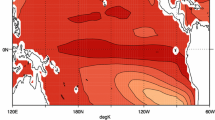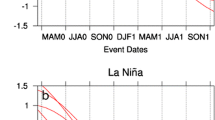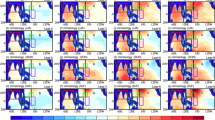Abstract
El Niño-Southern Oscillation (ENSO) plays a dominant role in interannual climate variability in Pacific island countries, directly affecting lives there. Many countries show different rainfall responses depending on the sea surface temperature (SST) structure of different types of El Nino events. El Niño events are classified into three types based on previous studies: those with strongest SST anomalies in the eastern Pacific Cold Tongue region (CTE), in the Western Pacific Warm Pool region (WPE), and those in between, a “Mixed” El Niño (MxE), and results from 30 CMIP5 models are investigated. These models accurately reproduce observed SST and precipitation anomalies for the three El Niño types and La Niña. CMIP5 models simulate much larger ranges in the strength of ENSO events than observed. Results clarify the roles of both the different structures of El Niño SST anomalies and their magnitudes on rainfall in the Pacific, and demonstrate that each of the three El Niño types has different impacts on rainfall in the region. These impacts vary with location, with WPE and CTE producing very different impacts in most Pacific island countries. There is a linear intensification of both the mean and maximum rainfall anomalies in the equatorial Pacific as the events become stronger. Equatorial rainfall shifts eastward in CTE and MxE, westward in La Niña. Both the South Pacific and Intertropical Convergence Zones (SPCZ and ITCZ) shift equatorward in El Niño and poleward in La Niña, the shifts increasing as events strengthen. WPE show different behaviour to other events, with little east-west shift in equatorial rainfall, and the orientation angle of the convergence zones increases. Identification of models with no erroneous westward bias in SST anomalies has clarified the effect of strong CTE events producing “zonal” SPCZ and shifting rainfall away to the east from western equatorial countries.









Similar content being viewed by others
References
Ashok K, Behera SK, Rao SA, Weng H, Yamagata T (2007) El Niño Modoki and its possible teleconnection. J Geophys Res Oceans (1978–2012) 112(C11007). doi:10.1029/2006JC003798
Australian Bureau of Meteorology and CSIRO (2011) Climate change in the Pacific: scientific assessment and new research, volume 1: regional overview. Technical report, 257 pp
Bellenger H, Guilyardi E, Leloup J, Lengaigne M, Vialard J (2014) ENSO representation in climate models: from CMIP3 to CMIP5. Clim Dyn 42:1999–2018
Brown JR, Power SB, Delage FP, Colman RA, Moise AF, Murphy BF (2011) Evaluation of the South Pacific Convergence Zone in IPCC AR4 climate model simulations of the twentieth century. J Clim 24(6):1565–1582
Cai W, Lengaigne M, Borlace S, Collins M, Cowan T, McPhaden MJ, Timmermann A, Power S, Brown J, Menkes C (2012) More extreme swings of the South Pacific convergence zone due to greenhouse warming. Nature 488(7411):365–369
Chung C, Power S, Arblaster J, Rashid H, Roff G (2013) Nonlinear precipitation response to El Niño and global warming in the Indo-Pacific. Clim Dyn 1–20. doi:10.1007/s00382-013-1892-8
Ebert EE, Gallus WA Jr (2009) Toward better understanding of the contiguous rain area (CRA) method for spatial forecast verification. Weather Forecast 24(5):1401–1415
Irving DB, Perkins SE, Brown JR, Moise AF, Murphy BF, Muir LC, Colman RA, Power SB, Delage FP (2012) Evaluating global climate models for the Pacific island region. Clim Res 49(3):169–187
Kao H-Y, Yu J-Y (2009) Contrasting Eastern-Pacific and Central-Pacific types of ENSO. J Clim 22:615–632
Kim ST, Yu JY (2012) The two types of ENSO in CMIP5 models. Geophys Res Lett 39(11):L11704. doi:10.1029/2012GL052006
Kug JS, Jin FF, An SI (2009) Two types of El Niño events: cold tongue El Niño and warm pool El Niño. J Clim 22(6):1499–1515
McPhaden MJ, Zebiak SE, Glantz MH (2006) ENSO as an integrating concept in earth science. Science 314(5806):1740–1745
McPhaden M, Lee T, McClurg D (2011) El Niño and its relationship to changing background conditions in the tropical Pacific Ocean. Geophys Res Lett 38(15):L15709. doi:10.1029/2011GL048275
Moise AF, Delage FP (2011) New climate model metrics based on object-orientated pattern matching of rainfall. J Geophys Res Atmos (1984–2012) 116(D12108). doi:10.1029/2010JD01531
Mullan A (1995) On the linearity and stability of Southern Oscillation-climate relationships for New Zealand. Int J Climatol 15(12):1365–1386
Murphy B, Power S, McGree S (2014) The varied impacts of El Niño-Southern Oscillation on Pacific island climates. J Clim 27:4015–4036. doi:10.1175/JCLI-D-13-00130.1
Philander S (1990) El Niño, La Niña, and the Southern Oscillation. International Geophys Series 46. Academic Press, San Diego
Power S, Delage F, Chung C, Kociuba G, Keay K (2013) Robust twenty-first-century projections of El Niño and related precipitation variability. Nature 502(7472):541–545
Power S, Haylock M, Colman R, Wang X (2006) The predictability of interdecadal changes in ENSO activity and ENSO teleconnections. J Clim 19(19):4755–4771
Rasmusson EM, Carpenter TH (1982) Variations in tropical sea surface temperature and surface wind fields associated with the Southern Oscillation/El Niño. Monthly Weather Rev 110(5):354–384
Rayner N, Parker D, Horton E, Folland C, Alexander L, Rowell D, Kent E, Kaplan A (2003) Global analyses of sea surface temperature, sea ice, and night marine air temperature since the late nineteenth century. J Geophys Res Atmos (1984–2012) 108(D14): 4407. doi:10.1029/2002JD002670
Ren HL, Jin FF (2013) Recharge oscillator mechanisms in two types of ENSO. J Clim 26(17):6505–6523. doi:10.1175/JCLI-D-12-00601.1
Salinger M, Basher R, Fitzharris B, Hay J, Jones P, MacVeigh J, Schmidely-Leleu I (1995) Climate trends in the south-west Pacific. Int J Climatol 15(3):285–302
Smith I, Moise A, Inape K, Murphy B, Colman R, Power S, Chung C (2013) ENSO related rainfall changes over the New Guinea region. J Geophys Res Atmos 118:111. doi:10.1002/jgrd.50818
Taylor KE (2001) Summarizing multiple aspects of model performance in a single diagram. J Geophys Res Atmos (1984–2012) 106(D7):7183–7192
Taylor KE, Stouffer RJ, Meehl GA (2012) An overview of CMIP5 and the experiment design. Bull Am Meteorol Soc 93(4):485–498
Trenberth KE (1976) Spatial and temporal variations of the Southern Oscillation. Quart J R Meteorol Soc 102(433):639–653
Vincent DG (1994) The South Pacific convergence zone (SPCZ): a review. Monthly Weather Rev 122(9):1949–1970
Vincent EM, Lengaigne M, Menkes CE, Jourdain NC, Marchesiello P, Madec G (2011) Interannual variability of the South Pacific convergence zone and implications for tropical cyclone genesis. Clim Dyn 36(9–10):1881–1896
Weng H, Ashok K, Behera SK, Rao SA, Yamagata T (2007) Impacts of recent El Niño Modoki on dry/wet conditions in the Pacific rim during boreal summer. Clim Dyn 29(2–3):113–129
Xie P, Arkin PA (1997) Global precipitation a 17-year monthly analysis based on gauge observations, satellite estimates, and numerical model outputs. Bull Am Meteorol Soc 78(11):2539–2558
Yeh SW, Kug JS, Dewitte B, Kwon MH, Kirtman BP, Jin FF (2009) El Niño in a changing climate. Nature 461(7263):511–514
Yu JY, Kim ST (2010) Identification of central-Pacific and eastern-Pacific types of ENSO in CMIP3 models. Geophys Res Lett 37(15):L15705
Acknowledgments
This research was supported by the Pacific Australia Climate Change Science and Adaptation Planning Program (PACCSAP), a program supported by AusAID, in collaboration with the Department of Environment, and delivered by the Bureau of Meteorology and the Commonwealth Scientific and Industrial Research Organisation (CSIRO). The authors thank Aurel Moise and Ian Smith for constructive comments on the manuscript, and two anonymous reviewers for their helpful suggestions. We acknowledge the World Climate Research Programme’s Working Group on Coupled Modelling, which is responsible for CMIP, and we thank the climate modeling groups for producing and making available their model output. For CMIP the U.S. Department of Energy’s Program for Climate Model Diagnosis and Intercomparison provides coordinating support and led development of software infrastructure in partnership with the Global Organization for Earth System Science Portals.
Author information
Authors and Affiliations
Corresponding author
Rights and permissions
About this article
Cite this article
Murphy, B.F., Ye, H. & Delage, F. Impacts of variations in the strength and structure of El Niño events on Pacific rainfall in CMIP5 models. Clim Dyn 44, 3171–3186 (2015). https://doi.org/10.1007/s00382-014-2389-9
Received:
Accepted:
Published:
Issue Date:
DOI: https://doi.org/10.1007/s00382-014-2389-9




